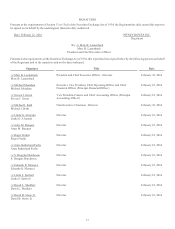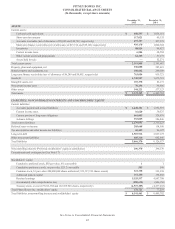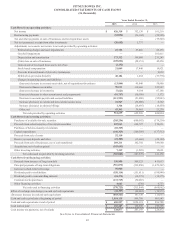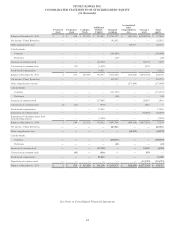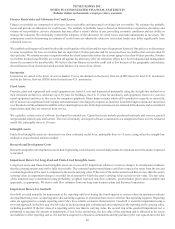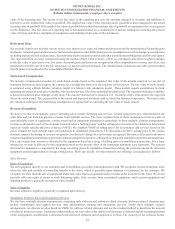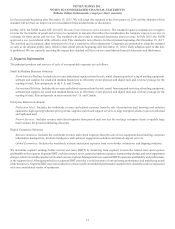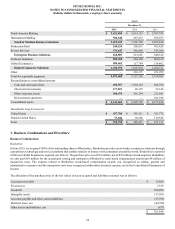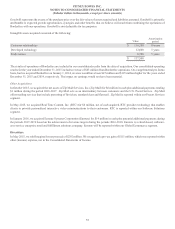Pitney Bowes 2015 Annual Report Download - page 62
Download and view the complete annual report
Please find page 62 of the 2015 Pitney Bowes annual report below. You can navigate through the pages in the report by either clicking on the pages listed below, or by using the keyword search tool below to find specific information within the annual report.PITNEY BOWES INC.
NOTES TO CONSOLIDATED FINANCIAL STATEMENTS
(Tabular dollars in thousands, except per share amounts)
46
Finance Receivables and Allowance for Credit Losses
Finance receivables are composed of sales-type lease receivables and unsecured revolving loan receivables. We estimate the probable
losses and provide an allowance for credit losses. The estimate of probable losses is based on historical loss experience, the nature and
volume of our portfolios, adverse situations that may affect a client's ability to pay, prevailing economic conditions and our ability to
manage the collateral. We continually evaluate the adequacy of the allowance for credit losses and make adjustments as necessary. The
assumptions used in determining an estimate of credit losses are inherently subjective and actual results may differ significantly from
estimated reserves.
We establish credit approval limits based on the credit quality of the client and the type of equipment financed. Our policy is to discontinue
revenue recognition for lease receivables that are more than 120 days past due and for unsecured loan receivables that are more than 90
days past due. We resume revenue recognition when the client's payments reduce the account aging to less than 60 days past due. Finance
receivables deemed uncollectible are written off against the allowance after all collection efforts have been exhausted and management
deems the account to be uncollectible. We believe that our finance receivable credit risk is low because of the geographic and industry
diversification of our clients and small account balances for most of our clients.
Inventories
Inventories are stated at the lower of cost or market. Cost is determined on the last-in, first-out (LIFO) basis for most U.S. inventories
and on the first-in, first-out (FIFO) basis for most non-U.S. inventories.
Fixed Assets
Property, plant and equipment and rental equipment are stated at cost and depreciated principally using the straight-line method over
their estimated useful lives, which are up to 50 years for buildings, three to 15 years for machinery and equipment, four to six years for
rental equipment and three to five years for computer equipment. Major improvements which add to productive capacity or extend the
life of an asset are capitalized while repairs and maintenance are charged to expense as incurred. Leasehold improvements are amortized
over the shorter of the estimated useful life or the remaining lease term. Fully depreciated assets are retained in fixed assets and accumulated
depreciation until they are removed from service.
We capitalize certain costs of software developed for internal use. Capitalized costs include purchased materials and services, payroll
and personnel-related costs and interest. The cost of internally developed software is amortized on a straight-line basis over its estimated
useful life, principally three to 10 years
Intangible assets
Finite-lived intangible assets are amortized over their estimated useful lives, principally three to 15 years, using either the straight-line
method or an accelerated attrition method.
Research and Development Costs
Research and product development costs include engineering costs related to research and product development activities and are expensed
as incurred.
Impairment Review for Long-lived and Finite-Lived Intangible Assets
Long-lived assets and finite-lived intangible assets are reviewed for impairment whenever events or changes in circumstances indicate
that the carrying amount may not be fully recoverable. The estimated undiscounted future cash flows expected to result from the use and
eventual disposition of the asset is compared to the asset's carrying value. If the sum of the undiscounted cash flows is less than the asset's
carrying value, an impairment charge is recorded for an amount by which the asset's carrying value exceeds its fair value. The fair value
of the impaired asset is determined using probability weighted expected cash flow estimates, quoted market prices when available and
appraisals, as appropriate. We derive cash flow estimates from our long-term business plans and historical experience.
Impairment Review for Goodwill
Goodwill is tested annually for impairment at the reporting unit level during the fourth quarter or sooner when circumstances indicate
an impairment may exist. A reporting unit is the operating segment, or a business that is one level below that operating segment. Reporting
units are aggregated as a single reporting unit if they have similar economic characteristics. Goodwill is tested for impairment using a
two-step approach. In the first step, the fair value of each reporting unit is determined and compared to the reporting unit's carrying value,
including goodwill. If the fair value of a reporting unit is less than its carrying value, the second step of the goodwill impairment test is
performed to measure the amount of impairment, if any. In the second step, the fair value of the reporting unit is allocated to the assets
and liabilities of the reporting unit as if it had been acquired in a business combination and the purchase price was equivalent to the fair



